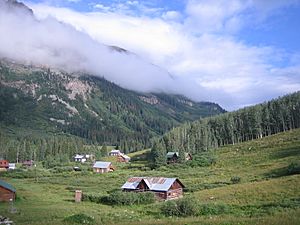Rocky Mountain Biological Laboratory facts for kids

Several RMBL buildings in Gothic, Colorado
|
|
| Established | 1928 |
|---|---|
| Research type | High-altitude biological field station |
| Staff | 180 |
| Location | Crested Butte, Colorado, United States 38°57′33″N 106°59′23″W / 38.9592°N 106.9897°W |
| Affiliations | Organization of Biological Field Stations |
| Map | |
The Rocky Mountain Biological Laboratory (also called RMBL — pronounced 'rumble') is a special science center. It is located high up in the West Elk Mountains of Colorado. You can find it near Crested Butte, in an old mining town called Gothic.
RMBL was started in 1928. Scientists and students come here to study nature. They learn about how living things interact with their environment. They also study climate change, how plants are pollinated, and yellow-bellied marmots. RMBL offers classes for college students. It also helps researchers from different universities.
Contents
History of RMBL
The Rocky Mountain Biological Laboratory began in 1928. It was built in Gothic, Colorado, which was once a busy mining town. Today, about 180 people live and work there during the summer. Scientists at RMBL have published over 1,500 research papers. This means they have shared their discoveries with the world.
Amazing Research at RMBL
The area around Gothic, Colorado, is very well understood. This is because of all the research done at RMBL. Scientists can study many topics related to the local environment. Some research areas have become very important over time.
Studying Butterflies
Many scientists have studied butterflies at RMBL. Charles Remington was a famous butterfly expert. He spent years studying butterfly genetics here. Other scientists like Paul R. Ehrlich and Naomi Pierce also worked on butterflies. They learned a lot about these colorful insects.
Genetics Research
Some geneticists also came to RMBL in the summer. Geneticists study how traits are passed down. Edward Novitski did important work on fruit flies (Drosophila melanogaster). His research was so creative that a special award was named after him. The Edward Novitski Prize honors amazing ideas in genetics.
Understanding Climate Change
Climate change is a big topic studied at RMBL. Scientists like John Harte work here. He has been warming a mountain meadow for a long time. He wants to see how warming affects the soil. He also studies how it changes plant life. This helps us understand what might happen as the climate changes.
The Science of Pollination
Pollination biology is another strong research area. Pollination is how plants make seeds. Many scientists have visited RMBL since the 1970s. Honeybees do not live well at these high elevations. This means scientists can study how native insects pollinate plants. Researchers like David Inouye have done important work here.
Long-Term Animal Studies
RMBL is home to a very long study of yellow-bellied marmots. These are furry animals that live in the mountains. Kenneth Barclay Armitage started this study in 1962. It is one of the longest studies of a wild animal in the world. Daniel T. Blumstein continues this important research today.
RMBL also has a long record of when flowers bloom. This record started in 1973. It helps scientists see how plants are changing over time. David Inouye and his team keep this record going.
Exploring Stream Ecosystems
Stream ecology is another important focus. This is the study of living things in streams. J. David Allan studied streams around RMBL in the 1970s. He even wrote a book about stream ecology. Barbara Peckarsky is a top stream ecologist. She has worked on these streams for over 30 years. She works with scientists from all over the world.
Bacteria and Ticks
Scientists at RMBL also study bacteria and ticks. Ticks are tiny creatures that can carry bacteria. This research helps us understand how these tiny living things interact. It also helps us learn about diseases they can carry.
Scientists and Policy
Many scientists who worked at RMBL have helped shape environmental policy. John P. Holdren was a science advisor to President Obama. Paul Ehrlich wrote a famous book called The Population Bomb. Michael Soulé started the Society for Conservation Biology. These scientists helped make important decisions about our environment.
Fun Traditions
Some scientists at RMBL have a fun tradition. They march in the Crested Butte, Colorado Fourth of July parade. They wear skirts made of corn lily leaves. They play music with trombones, kazoos, and pots and pans. It's a fun way to share their love for science!
RMBL is part of the Organization of Biological Field Stations.


